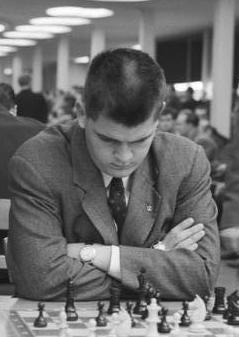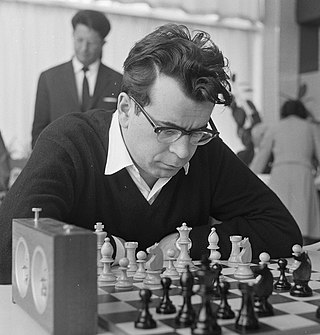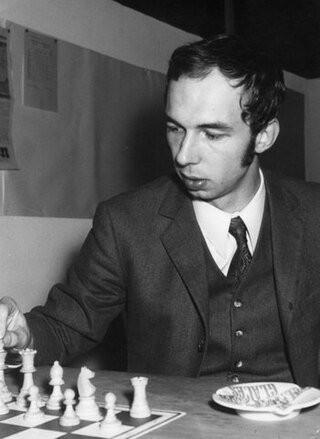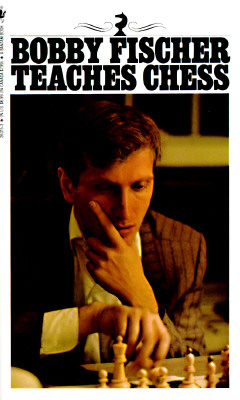Related Research Articles

David Neil Laurence Levy is an International Master of chess who plays for Scotland, and a businessman. He is noted for his involvement with computer chess and artificial intelligence, and as the founder of the Computer Olympiads and the Mind Sports Olympiads. He has written more than 40 books on chess and computers.

Robert Eugene Byrne was an American chess player and chess author who held the FIDE title of Grandmaster (GM). He won the U.S. Championship in 1972, and was a World Chess Championship Candidate in 1974. Byrne represented the United States nine times in Chess Olympiads from 1952 to 1976 and won seven medals. He was the chess columnist from 1972 to 2006 for The New York Times, which ran his final column on November 12, 2006. Byrne worked as a university professor for many years, before becoming a chess professional in the early 1970s.

Larry Melvyn Evans was an American chess player, author, and journalist who received the FIDE title of Grandmaster (GM) in 1957. He won or shared the U.S. Chess Championship five times and the U.S. Open Chess Championship four times. He wrote a long-running syndicated chess column and wrote or co-wrote more than twenty books on chess.
Leonard William Barden is an English chess master, writer, broadcaster, journalist, organizer and promoter. The son of a dustman, he was educated at Whitgift School, South Croydon, and Balliol College, Oxford, where he read modern history. Barden learned to play chess at age 13 while in a school shelter during a World War II German air raid. Within a few years he became one of the country's leading juniors. Barden represented England in four Chess Olympiads. He played a major role in the rise of English chess from the 1970s. Barden is a chess columnist for various newspapers. His column in London's Evening Standard is the world's longest-running daily chess column by the same author.

Walter Shawn Browne was an Australian-born American chess and poker player. Awarded the title Grandmaster by FIDE in 1970, he won the U.S. Chess Championship six times.

William James Joseph Lombardy was an American chess grandmaster, chess writer, teacher, and former Catholic priest. He was one of the leading American chess players during the 1950s and 1960s, and a contemporary of Bobby Fischer, whom he seconded during the World Chess Championship 1972. He won the World Junior Championship in 1957, the only person to win that tournament with a perfect score. Lombardy led the U.S. Student Team to Gold in the 1960 World Student Team Championship in Leningrad.

Arthur Bernard Bisguier was an American chess player, chess promoter, and writer who held the FIDE title of Grandmaster (GM).

Pal Charles Benko was a Hungarian and American chess player, author, and composer of endgame studies and chess problems.

Robert James Fischer was an American chess grandmaster and the eleventh World Chess Champion. A chess prodigy, he won his first of a record eight US Championships at the age of 14. In 1964, he won with an 11–0 score, the only perfect score in the history of the tournament. Qualifying for the 1972 World Championship, Fischer swept matches with Mark Taimanov and Bent Larsen by 6–0 scores. After winning another qualifying match against Tigran Petrosian, Fischer won the title match against Boris Spassky of the USSR, in Reykjavík, Iceland. Publicized as a Cold War confrontation between the US and USSR, the match attracted more worldwide interest than any chess championship before or since.

Lubomir (Lubosh) Kavalek was a Czech-American chess player. He was awarded both the International Master and International Grandmaster titles by FIDE in 1965. He won two Czechoslovak and three U.S. championships, and was ranked as the world's No. 10 player in 1974. He was inducted into the U.S. Chess Hall of Fame in 2001. Kavalek was also a chess coach, organizer, teacher, commentator, author and award-winning columnist.
Duncan Suttles is a chess grandmaster. Canada's second grandmaster after Abe Yanofsky, Suttles was recognized internationally for the originality of his strategic play in the mid-1960s and 70s. He retired from competitive chess in 1985.
Israel Albert Horowitz was an American International Master of chess. He is most remembered today for the books he wrote about chess. In 1989 he was inducted into the World Chess Hall of Fame.
David Brine Pritchard was a British chess player, chess writer and indoor games consultant. He gained pre-eminence as an indoor games and mind sports consultant, a role that he in effect created. A natural games player, it was to him that inventors or publishers would turn to organise a championship of a new game, write about it or generally promote it.

Wesley Barbossa So is a Filipino and American chess grandmaster and three-time U.S. Chess Champion. He is also a three-time Philippine Chess Champion. On the March 2017 FIDE rating list, he was ranked number two in the world and had an Elo rating of 2822, making him the fifth-highest-rated player in history.

Peter Biyiasas is a Canadian chess grandmaster. He was Canadian champion in 1972 and 1975, represented Canada with success on four Olympiad teams, and played in two Interzonals. He moved to the United States in 1979, settling in California. He retired from competitive play in the mid-1980s to work as a computer programmer. During the late 1970s and early 1980s, he was a frequent training partner of Bobby Fischer, who stayed at his home in San Francisco for extended periods.

Susan Polgar is a Hungarian-American chess grandmaster. Polgár was Women's World Chess Champion from 1996 to 1999. On FIDE's Elo rating system list of July 1984, at the age of 15, she became the top-ranked female chess player in the world. In 1991, she became the third woman to be awarded the title of Grandmaster by FIDE. She won eleven medals at the Women's Chess Olympiad.

William John Donaldson, known as John Donaldson, is an American chess player, author, journalist and chess official. Like many of his contemporaries, he began playing in the aftermath of the World Chess Championship 1972 between Fischer and Spassky. He joined the Tacoma Chess Club in September 1972, and is still involved with the game almost 50 years later.

Bobby Fischer Teaches Chess is a chess puzzle book written by Bobby Fischer and co-authored by Stuart Margulies and Donn Mosenfelder, originally published in 1966. It is one of the best-selling chess books of all time, with over one million copies sold.
Eva Karolina Aronson was a Sweden-born American chess player who held the title of Woman International Master. She was a winner the U.S. Women's Chess Championship (1972).
George Kuprejanov was a Canadian chess master.
References
- ↑ "mcc_content". FROONT.
- ↑ "1973 US Chess Championship". graeme.50webs.com.
- ↑ "OlimpBase :: Men's Chess Olympiads :: George Francis Kane". olimpbase.org.